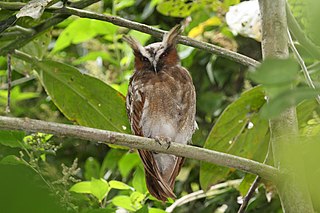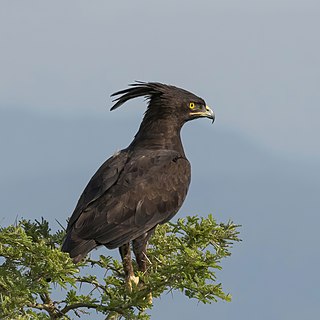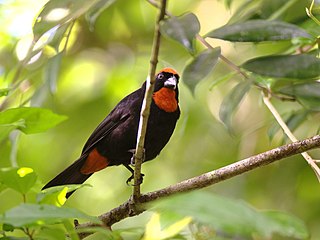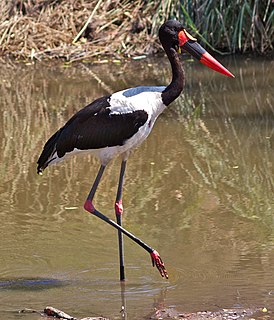 W
WThe African fish eagle or the African sea eagle, is a large species of eagle found throughout sub-Saharan Africa wherever large bodies of open water with an abundant food supply occur. It is the national bird of Namibia and Zambia. As a result of its large range, it is known in many languages. Examples of names include: nkwazi in Chewa, aigle pêcheur in French, hungwe in Shona, inkwazi in isiZulu, and 'ntšhu' in Northern Sotho. This species may resemble the bald eagle in appearance; though related, each species occurs on different continents, with the bald eagle being resident in North America.
 W
WThe African goshawk is a species of African bird of prey in the genus Accipiter which is the type genus of the family Accipitridae.
 W
WThe African marsh harrier is a bird of prey belonging to the harrier genus Circus. It is largely resident in wetland habitats in southern, central and eastern Africa from South Africa north to South Sudan.
 W
WThe bat falcon is a falcon that is a resident breeder in tropical Mexico, Central and South America, and Trinidad. It was long known as Falco albigularis; the names Falco fusco-coerulescens or Falco fuscocaerulescens, long used for the aplomado falcon, are now believed to refer to the present species.
 W
WThe black-banded owl is a species of owl in the family Strigidae. Entirely nocturnal, this midsized black and white neotropical bird is a resident species, therefore never migrates out of its native South America. Its natural habitats are varied subtropical or tropical forests ranging from lowlands to areas of medium altitude, and it has been found in Argentina, Bolivia, Brazil, Colombia, Ecuador, French Guiana, Guyana, Paraguay, Peru, Suriname, and Venezuela.
 W
WThe black-throated grosbeak is a seed-eating passerine bird in the tanager family Thraupidae.
 W
WThe black-winged starling is a species of starling in the family Sturnidae. The species is also known as the black-winged myna or the white-breasted starling. It is endemic to Indonesia. There are three recognised subspecies: the nominate race, which occurs across much of the island of Java; tricolor, which is restricted to south east Java; and tertius, which is found on Bali and possibly Lombok. The validity of the records on Lombok has been called into question, as there are only a few records and those may represent escapees from the caged-bird trade or natural vagrants. The species has often been assigned to the starling genus Sturnus, but is now placed in Acridotheres because it is behaviourally and vocally closer to the birds in that genus.
 W
WThe collared lory is a species of parrot in the family Psittaculidae, and it is the only species in the genus Phigys. It is endemic to the islands of Fiji. It is the only Fijian rainforest bird to adapt to urban landscapes and can be found in urban Suva. Measuring 20 cm (7.9 in), it has bright red underparts and face with a purple crown and greenish upperparts. Males and females are similar in plumage, although the latter have a paler crown.
 W
WThe crested eagle is a large Neotropical eagle.
 W
WThe crested owl is a species of owl in the family Strigidae. It is the only species (monotypic) in the genus Lophostrix. It is a resident bird and occurs in Central America and northern South America. It is a medium-sized owl, easily recognizable with its very long whitish ear tufts and otherwise darker appearance. It inhabits lowland rainforests and prefers old growth in proximity with water. The crested owl is a strictly nocturnal species, but very little is known about its behaviour.
 W
WThe gabar goshawk is a small species of African and Arabian bird of prey in the family Accipitridae.
 W
WThe little sparrowhawk is a species of Afrotropical bird of prey in the family Accipitridae. It is the smallest member of the genus Accipiter and forms a superspecies with the red-thighed sparrowhawk.
 W
WThe long-crested eagle is an African bird of prey. Like all eagles, it is in the family Accipitridae. It is currently placed in a monotypic genus Lophaetus.
 W
WThe martial eagle is a large eagle native to sub-Saharan Africa. It is the only member of the genus Polemaetus. A species of the booted eagle subfamily (Aquillinae), it has feathering over its tarsus. One of the largest and most powerful species of booted eagle, it is a fairly opportunistic predator that varies its prey selection between mammals, birds and reptiles. Its hunting technique is unique as it is one of few eagle species known to hunt primarily from a high soar, by stooping on its quarry. An inhabitant of wooded belts of otherwise open savanna, this species has shown a precipitous decline in the last few centuries due to a variety of factors. The martial eagle is one of the most persecuted bird species in the world. Due to its habit of taking livestock and regionally valuable game, local farmers and game wardens frequently seek to eliminate martial eagles, although the effect of eagles on this prey is almost certainly considerably exaggerated. Currently, the martial eagle is classified with the status of Vulnerable to extinction by the IUCN.
 W
WThe ornate hawk-eagle is a fairly large bird of prey from the tropical Americas. Formerly, some authorities referred to this species as the crested hawk-eagle, a name that may cause some confusion as it is more commonly used for an Asian eagle species. Like all eagles, it is in the family Accipitridae. This species has a feathered tarsus that marks it as a member of the Aquilinae or booted eagle subfamily. This species is notable for the vivid colors and bold markings of adults, which differ considerably from the far more whitish plumage of the juvenile bird. The ornate hawk-eagle ranges from central Mexico south through much of Central America and in a somewhat spotty but broad overall range into South America, including in the west apart from the Andes and broadly on the Atlantic side especially Brazil down to as far as Southeast Brazil and northern Argentina. This species is found largely in primary forests with tall trees, although can be found in many forest types. The ornate hawk-eagle female lays almost always a single egg and the species has a fairly prolonged breeding cycle like many tropical raptors, especially due to a lengthy post-fledging stage on which juveniles are dependent on their parents. It a diversified and exceptionally powerful predator which takes a range of prey, usually led by various medium-to-large-sized birds and small-to-medium-sized mammals as well as occasional reptiles. Like many forest-dependent raptors, especially those in the tropical and subtropical regions, this species is likely under the pressing threat of deforestation. The decline of forest habitat in this species range, especially the Amazon rainforest, led the IUCN to uplist the ornate hawk-eagle as Near Threatened in 2016.
 W
WThe pale-winged starling is a species of starling in the family Sturnidae. It is found in Angola, Botswana, Namibia, and South Africa.
 W
WThe Principe starling, also known as the Príncipe glossy-starling, is a species of starling in the family Sturnidae. It is endemic to São Tomé and Príncipe. Its natural habitat is subtropical or tropical moist lowland forests.
 W
WThe Puerto Rican bullfinch or comeñame in Spanish, is a small bullfinch tanager endemic to the archipelago of Puerto Rico. These were previously considered Emberizidae. The Puerto Rican bullfinch has black feathers with red areas above the eyes, around its throat, and underneath the tail's base. The species measures from 17 to 19 cm and weighs approximately 32 grams.
 W
WThe Puerto Rican owl or múcaro is a nocturnal endemic owl of the archipelago of Puerto Rico belonging to the genus Gymnasio of the family Strigidae. The subspecies, G. n. newtoni, which was endemic to the Virgin Islands, was locally referred to as the cuckoo bird.
 W
WThe purple roller, or rufous-crowned roller, is a medium-sized bird widespread in sub-Saharan Africa. Compared with other rollers its colours are rather dull and its voice rather harsh and grating.
 W
WThe racket-tailed treepie is an Asian treepie, a member of the crow family, Corvidae.
 W
WThe red bird-of-paradise, is a bird-of-paradise in the genus Paradisaea, family Paradisaeidae.
 W
WThe red-necked falcon is a bird of prey in the falcon family with two disjunct populations, one in India and the other in Africa. This medium-sized falcon has bluish grey wings and upper body, a chestnut red cap with short chin straps passing through the eye. The primary feathers of the wing are black and a single black band at the tip of the tail are distinctive. The Indian subspecies Falco chicquera chicquera also known as the red-headed merlin or red-headed falcon is found mainly in the open plains of the India Subcontinent although it is thought to have occurred further west in southeastern Iran. The subspecies Falco chicquera ruficollis found in sub-Saharan Africa is sometimes treated as a full species, the rufous-necked falcon, on the basis of its well-separated geographic range and distinctive pattern. It appears very similar to the Indian form but has dark barring on the upperparts, a rufous breast band, and black moustachial and eye stripes. As in most falcons, the females are larger and falconers in India called the female turumti and the male as chatwa. They hunt in pairs mostly at dawn and dusk, capturing small birds, bats and squirrels.
 W
WThe rock kestrel is a bird of prey species belonging to the kestrel group of the falcon family Falconidae. It was previously considered a subspecies of the common kestrel.
 W
WThe saddle-billed stork, or saddlebill is a large wading bird in the stork family, Ciconiidae. It is a widespread species which is a resident breeder in sub-Saharan Africa from Sudan, Ethiopia and Kenya south to South Africa, and in The Gambia, Senegal, Côte d'Ivoire and Chad in west Africa. Considered Endangered in South Africa.
 W
WThe twelve-wired bird-of-paradise is a medium-sized, approximately 33 cm (13 in) long, velvet black and yellow bird-of-paradise. The male has a red iris, long black bill and rich yellow plumes along his flanks. From the rear of these plumes emerge twelve blackish, wire-like filaments, which bend back near their bases to sweep forward over the bird's hindquarters. The female is a brown bird with black-barred buffy underparts. Their feet are strong, large-clawed and pink in color.
 W
WThe white-necked crow is the largest of the four Caribbean corvids. It is endemic to the island of Hispaniola. It was formerly also found on Puerto Rico, but is extirpated there, due to considerable forest clearance and hunting.
 W
WThe yellow wattlebird is a species of bird in the honeyeater family Meliphagidae. Other names include the long or Tasmanian wattlebird.